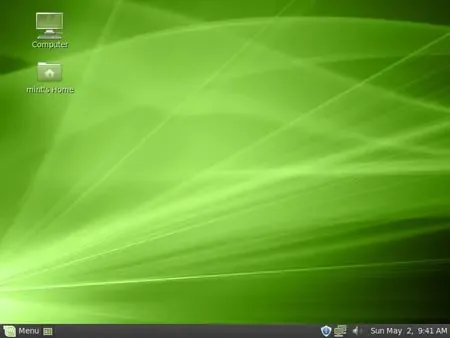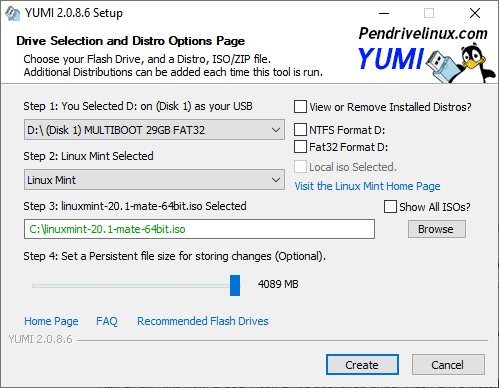Make a USB Bootable Linux Mint Flash Drive with Persistence: Run Linux Mint from USB and also use it to install Linux Mint from USB to a hard drive. In the following tutorial, I cover one way to use YUMI to create your own portable version of this distribution from Windows. Additionally, I’ll include instructions for using the dd command to create a bootable USB with persistence.
USB Bootable Linux Mint Running with Persistence

Linux Mint is a popular Linux desktop distribution that focuses on providing an intuitive and user-friendly experience for its users. It is based on Ubuntu or Debian (depending on the version). Features include a new software manager, new backup tool, streamlined look and feel, multiple desktop environments to choose from, and quicker boot times.
Linux Mint Features
- Linux Mint Cinnamon: The flagship desktop environment, providing a traditional interface similar to Windows.
- Linux Mint MATE: Offers a retro-style interface suitable for older hardware.
- Linux Mint XFCE: A lightweight interface based on GTK, ideal for performance on older systems.
- Linux Mint Debian Edition: A rolling release model built on a Debian base.
- Linux Mint Software Manager: User-friendly software installation and management.
- Linux Mint Update Manager: Control over system updates and security patches.
- Linux Mint Driver Manager: Helps install drivers for hardware components.
- Mint Tools: Utilities for system configuration and backups.
- Nemo File Manager: Offers dual-pane browsing and built-in previews.
- System Settings: Intuitive customization options for the desktop environment.
- Software Sources: Manage software repositories easily.
- Ubuntu/Debian Compatibility: Extensive software package ecosystem.
Linux Mint Specifications
- Distribution Website: Project Page
- Developer: Headed by Clement Lefebvre
- Release Date: First released in 2006
- Persistent Feature: Yes
- ISO Files Link: Linux Mint Download
Essentials to Make Linux Mint Boot from USB
- Computer that can boot from USB
- Windows 11, 10, 8, 7 Operating Environment
- USB flash drive (a fast solid-state drive is recommended)
- Linux Mint ISO file
- YUMI (USB boot creator) or dd for Windows
How to Make a Persistent Linux Mint Bootable USB
You can use YUMI multiboot software to easily make a Linux Mint USB boot with persistence. Here's how:
Method 1: Using YUMI
- Download and launch the YUMI Bootable USB creation software.
- (1.) Select your flash drive from the list of devices.
(2.) Choose Linux Mint from the list of distributions.
(3.) Download and then browse to your Linux Mint ISO file.
(4.) Optionally, set a persistent file size for storing changes, and click Create.
- Once the YUMI script has finished:
(1.) Restart your PC.
(2.) Access UEFI or BIOS settings using your hotkey during system startup.
(3.) Set your USB flash drive to be the first boot device.
(4.) Save changes and reboot to boot from the USB drive.
(5.) During startup, you should see a YUMI boot menu that offers the option to run a Live USB bootable Linux Mint from your flash drive.
Method 2: Using dd for Windows
You can also create a bootable USB drive using the dd command in Windows. Here’s how:
- Download and Install WSL (Windows Subsystem for Linux): Open PowerShell as Administrator and run:
wsl --installRestart your computer if prompted.
- Open WSL: After restarting, open the WSL terminal from the Start menu.
- Identify the USB Drive: Insert your USB drive and run:
lsblkNote the device name (e.g., /dev/sdb).
- Unmount the USB Drive (if mounted): Ensure the USB is unmounted with:
sudo umount /dev/sdXReplace sdX with your USB device.
- Use the dd Command: Execute the following command to write the ISO to USB:
sudo dd if=/path/to/linuxmint.iso of=/dev/sdX bs=4M status=progressReplace /path/to/linuxmint.iso with the path to your ISO and sdX with your USB.
- Sync and Eject: After the command completes, run:
syncEject your USB safely.
- Create a Persistent Overlay: To add persistence, create a persistence file on your USB drive:
- Create a mount point for the USB drive:
mkdir /mnt/usbThis step creates a directory that will serve as a mount point for the USB drive.
- Mount the USB drive partition:
sudo mount /dev/sdX1 /mnt/usbReplace
/dev/sdX1with the actual partition of your USB drive. Uselsblkto find the correct partition. - Create a blank persistence file:
sudo dd if=/dev/zero of=/mnt/usb/persistence.img bs=1M count=4096This command creates a 4GB blank file to be used for persistence. Change
count=4096to a larger or smaller number for different sizes (e.g.,count=8192for 8GB). - Format the persistence file as ext4:
sudo mkfs.ext4 /mnt/usb/persistence.imgThis formats the blank file as an ext4 filesystem, which is required for persistence.
- Rename the file to
casper-rw:sudo mv /mnt/usb/persistence.img /mnt/usb/casper-rwLinux Mint requires the persistence file to be named
casper-rwfor it to be recognized. - (Optional) Assign a label to the persistence file:
sudo e2label /mnt/usb/casper-rw casper-rwAssigning a label can help with compatibility, but this step is optional.
- Unmount the USB drive:
sudo umount /mnt/usbAlways unmount the USB drive to ensure all changes are safely written.
Don’t forget to add the
persistentboot parameter when starting Linux Mint from the USB drive to enable persistence.Now your USB drive is ready to use with persistence!
- Create a mount point for the USB drive:
Installing Linux Mint from USB

After booting up, you can easily install Linux Mint from your USB to an internal hard drive or another external device. Simply choose the "Install Linux Mint" option from the desktop to begin installing Linux Mint from USB.
